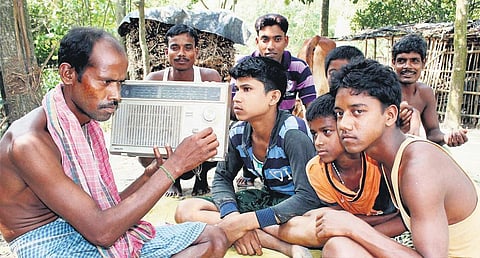

On April 24, 2023, an extraordinary thing happened. For the first time in India’s post-Independence history, the Central government sent out an ‘advisory’ to all television news channels and community radio stations to broadcast a politician’s address to the general public. It is not a diktat to popularise a policy. It is a diktat to spread, through official, governmental means, the personal word of a political leader—India’s leading politician, a divisively authoritarian figure. The advisory, as everyone in the news and information-dissemination business knows, is mandatory. Even though it is not a notified circular, it is no less an official imperative for that.
The programme in question is Prime Minister Narendra Modi’s 100th tranche of Mann Ki Baat, his monthly monologue, a pastiche of feel-good sage advice aired every last Sunday of a month to the nation. The first episode was aired on October 3, 2014, barely four months after he won the general election; the 100th is due on Sunday, April 30, 2023—and the dispensation has decided to make a self-promotional festival of it. Modi elocutes in Hindi, and this is translated into many languages, but, pointedly, not into English. This “historic event”, however, as the Union Ministry of Information and Broadcasting calls it, will be broadcast worldwide via communitarian video and invited gatherings at high commissions and consulates.
Mann Ki Baat is de rigueur on All India Radio, the world’s largest radio network with 262 stations, more than 375 private and community stations, 34 channels of the Doordarshan network, and 333 permitted private satellite TV channels. It is translated into 52 languages, including 11 foreign languages (and dialects and topolects seemingly drawn out of a hat and chosen with no particular regard to their volume of listenership). The diktat, camouflaged as an advisory, has gone out to all of them.
And it is a do-or-else situation. For instance, the Community Radio Station cell of the MIB issued instructions asking for “proof” of the broadcast having taken place in the shape and form of “a photo of the community listening to the broadcast as a memoir” to be sent to the ministry.
“Community Radio Stations are advised to send, a one-minute audio clip of the broadcast consisting of 25 seconds of the initial portion broadcast and 25 seconds of last portion of broadcast appending the name of the Community Radio Station, immediately after completion of the broadcast. The audio clip may be sent through link which shall be shared shortly.”
This demand for “proof of work” is unprecedented. What is striking about this is not so much a free-to-choose advisory but the explicit strong-arming. I do not recall the previous carrier of the national flag, the control-freak Indira Gandhi, ordering the broadcast media to carry her speeches even during the Emergency, not even when free news was being blacked out every day in the newspapers. Nor was this the case during the years of her son Rajiv Gandhi, who made a habit, camouflaged in disarming charm, of trying hard to micromanage the New Delhi media.
Not that this is the first time that government diktat has been imposed on the media: the Indian media has a history of ministerial tinpots and other politicians making rules out of their whims and whimsies. Two latter-day examples should suffice.
In June 2014, a month after it took power, the Modi government issued a diktat to all ministries and bureaucrats to open social media accounts on Twitter, Facebook and YouTube, with orders to update them at least once a week by August. This command followed upon guidelines laid by the previous UPA government in 2012, when only the Prime Minister’s Office (PMO) and the external affairs ministry had accounts. The UPA being more freewheeling, the other ministries ignored these guidelines. When the Modi government issued the “advisory”, everyone scrambled.
In late 2022, the MIB issued an “advisory” to Central government ministries, state governments and Union Territories that are distributing broadcasting content to withdraw from distribution activities before December 31, 2023. This is bound to strain already-taut Centre-state relations. Nearly every state government has formal and informal channels to slip its content into telecasts: for instance, the Tamil Nadu government owns and operates a cable-distribution company and an educational channel; and the Andhra Pradesh government runs a triple-pronged fibre-optics service that delivers television, internet, and telephony. These will be undone, but the Centre will, cleverly, retain its hold on Prasar Bharati, the state-owned public broadcaster headquartered in New Delhi.
For many reasons, the government’s latest “advisory” makes little sense. For one, although a survey by IIM Rohtak found that more than 100 crore people had listened to Mann Ki Baat at least once and 23 crore were regular listeners, the respected Centre for the Study of Developing Societies (CSDS) published a study called Media in India: Access, Practices, Concerns and Effects, in which a four-page section—PM’s Mann Ki Baat: A Reality Check—found that most Indian citizens weren’t interested.
“[Even] in the Hindi-speaking States, popularity/listenership of PMMKB is rather low. (...) [E]ven households that have a high media presence (TV, internet, stereo, etc), two-fifths had not heard Mann Ki Baat in the last one year and three in every ten had heard it once or twice.”
Among BJP supporters, 51% have not listened to Modi’s radio homily; 68% of Congress supporters, 67% of Others and the politically unattached have not heard a single episode. In all, 63.25% of those polled have no interest in Modi’s excursus.
The only assured listeners are 9% of households with high media presence, 4% with moderate media presence, and 2% with low media presence.
Which brings us to the crux of this exercise. What purpose, except that of domineering and peremptory self-promotion by employing instruments governmental and private alike?
Kajal Basu
Veteran journalist